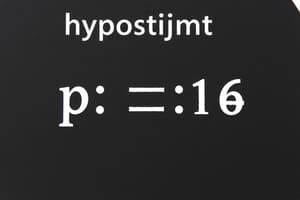Podcast
Questions and Answers
What is hypothesis testing?
What is hypothesis testing?
A process used to quantify belief against a particular hypothesis about a population.
Which step is NOT part of hypothesis testing?
Which step is NOT part of hypothesis testing?
- Calculate the mean of the sample (correct)
- Compute the p-value
- Choose the level of significance
- Define the null and alternative hypotheses
The null hypothesis assumes that there is a difference between the groups.
The null hypothesis assumes that there is a difference between the groups.
False (B)
What is an alpha error?
What is an alpha error?
What is a beta error?
What is a beta error?
What does a p-value less than 0.05 indicate?
What does a p-value less than 0.05 indicate?
What does p-value represent?
What does p-value represent?
The null hypothesis (Ho) states that no ______ exist between groups.
The null hypothesis (Ho) states that no ______ exist between groups.
Match the following terms with their definitions:
Match the following terms with their definitions:
Flashcards are hidden until you start studying
Study Notes
Hypothesis Testing
- Hypothesis testing is used to quantify belief against a particular hypothesis.
- It determines if there is sufficient evidence to reject a specific hypothesis.
- The null hypothesis assumes no difference between groups.
- The alternative hypothesis suggests there is a difference between groups.
Steps in Hypothesis Testing
- Define the null and alternative hypotheses.
- Choose the level of significance (usually 0.05 or less).
- Select and compute the test statistic (e.g., t-test, chi-square).
- Calculate the p-value.
- Compare the p-value to the level of significance to determine whether to reject the null hypothesis.
- Draw conclusions from the test.
Types of Errors in Research
- Type I error (α error): Incorrectly rejecting the null hypothesis when it is true (false positive).
- Type II error (β error): Incorrectly failing to reject the null hypothesis when it is false (false negative).
Probability Value (p-value)
- The p-value represents the probability of observing the obtained effect (or a stronger effect) if the null hypothesis is true.
- It indicates the likelihood of the observed difference occurring by chance.
- A p-value of less than 0.05 is typically used as a cutoff for rejecting the null hypothesis.
Interpretation of Results
- If the p-value is less than 0.05, reject the null hypothesis and accept the alternative hypothesis.
- If the p-value is greater than 0.05, accept the null hypothesis and reject the alternative hypothesis.
Studying That Suits You
Use AI to generate personalized quizzes and flashcards to suit your learning preferences.



